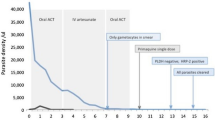Summary
A total of 125 β-thalassaemia patients receiving repeated blood transfusions were screened by Giemsa stain, Acridine-orange stain and antigen detection for evidence of malaria infection on each visit. A total of 8 (6.4%) of the patients developed post-transfusion malaria (PMT) as confirmed by tracing the infected blood donors. A high incidence of PTM in thalassaemia patients appears to be due to the use of fresh blood and the high frequency of blood transfusions required by these patients. Antigen detection using monoclonal antibody was found to be more sensitive for diagnosis of PTM and for screening suspected donors than the conventional blood smear examination methods and is therefore recommended for routine blood donor screening to rule out malaria infection.
Similar content being viewed by others
References
Friedman MJ (1979) Oxidant damage mediates variant red cell resistance to malaria. Nature 280: 245–247
Greenberg AE, Dinh PN, Mann JN, Kabote N, Colebunders RL, Francis H, Quinn TC, Baudoux P, Lymba B, Darachi F (1988) The association between malaria, blood transfusion and HIV seropositivity in a pediatric population in Kinshasa, Zaire. JAMA 259: 545–549
Haldane JBS (1949) Disease and evolution. Ric Sci 19 [Suppl): 68
Halsted JA, Halsted CH (1981) The laboratory in clinical medicine-interpretation and application (2nd edn). WB Saunders, Philadelphia, pp 898–899
Ifediba TC, Stern A, Ibrahim A, Rieder RF (1985)Plasmodium falciparum in vitro: Diminished growth in haemoglobin H disease erythrocytes. Blood 65: 452–455
Kaminsky R, Kruger N, Hempelmann E, Bommer W (1987) Reduced development ofP. falciparum in β-thalassaemia erythrocytes. Trop Dis Bull 84: 576–577
Livingstone FB (1971) Malaria and human polymorphism. Ann Rev Genet 5: 33–64
Lupascu G, Bossie Agavriloraei A, Bona C, Ioanid L, Smolinski M (1967) Valeur de la reaction d' immunofluorescence dans le depistage des parasitemies asymptomatiques a plasmodium malariae. Bull WHO 36: 485–490
Luzzatto L (1979) Genetics of red cell and susceptibility to malaria. Blood 54: 961–976
Shute GT, Sodeman TM (1973) Identification of malaria parasite by fluorescence microscopy and acridine orange staining. Bull WHO 48: 591–596
Trager W, Jensen JB (1976) Human malaria parasite in continous culture. Science 193: 673–675
Widmann FK (1985) Technical manual (9th edn) American Association of Blood Banks, Arlington, USA
Willcox M, Bjorkman A, Brohult J (1983) A case control study in northern Liberia ofP. falciparum malaria in Hb-S and β-thalassaemia traits. Ann Trop Med Parasitol 77: 239–246
Author information
Authors and Affiliations
Rights and permissions
About this article
Cite this article
Choudhury, N.J., Dubey, M.L., Jolly, J.G. et al. Post-transfusion malaria in thalassaemia patients. Blut 61, 314–316 (1990). https://doi.org/10.1007/BF01732885
Received:
Accepted:
Issue Date:
DOI: https://doi.org/10.1007/BF01732885




